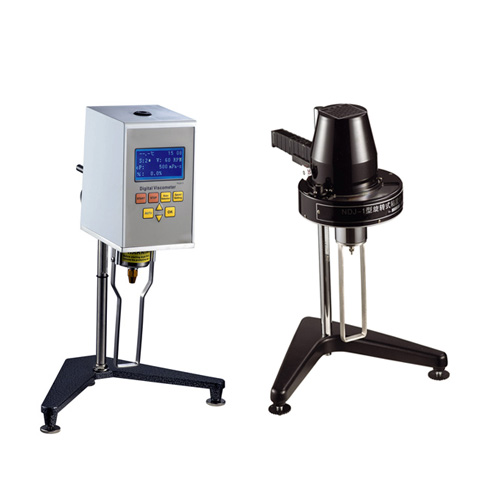
Rotational viscometers are widely used to measure the dynamic viscosity of various fluids such as oils, paints, coatings, plastics, food, medicines, and adhesives.
Basic principle: A synchronous micro-motor drives the drum to rotate in the measured fluid at a certain speed. Due to the action of fluid viscous force, the drum will lag behind, and the elastic element connected to the drum will rotate at a certain speed. A certain twist is generated in the opposite direction, and the sensor measures the magnitude of the torsional stress, thereby obtaining the viscosity value of the fluid.
The rotary viscometer is a relatively precise instrument, suitable for measuring Newtonian fluid and non-Newtonian fluid at the same time. It is easy to use, fast and convenient to measure, accurate and reliable data, and has a wide range of viscosity measurement (about 1~10000000mPa?s). By adjusting the rotation speed, the fluid viscosity at different shear rates can be measured, which is convenient for continuous measurement. It is used in industrial production. A wide range of viscometers.
Today, the editor will tell you about the maintenance skills of the rotational viscometer:
- The performance indicators of the instrument must meet the requirements of the National Metrology Verification Regulations. The instruments in use should be checked periodically, and if necessary (the instrument is frequently used or in a critical state), an intermediate self-inspection should be carried out to ensure that its measurement performance is qualified and the coefficient error is within the allowable range, otherwise accurate data cannot be obtained.
- Pay special attention to the temperature of the measured liquid. Many users ignore this point and think it doesn’t matter if the temperature is slightly different. Our experiments have proved that: when the temperature deviation is 0.5°C, the deviation of the viscosity value of some liquids exceeds 5%. The temperature deviation has a great influence on the viscosity. Therefore, special attention should be paid to keeping the temperature of the liquid to be measured constant near the specified temperature point, and the measurement should not exceed 0.1°C.
- Selection of measuring container (outer cylinder). Carefully read the instrument manual, different rotors (inner cylinders) match the corresponding outer cylinders, otherwise the measurement results will deviate greatly. In principle, the radius of the outer cylinder is required to be infinite, and the actual measurement requires that the inner diameter of the outer cylinder, that is, the measuring container, is not less than a certain size. It is required that the diameter of the measuring beaker or straight container is not less than 70mm. The experiment proves that especially when the No. 1 rotor is used, if the inner diameter of the container is too small, a large measurement error will be caused.
- Cleaning of the rotor. The measuring rotor (including the outer cylinder) should be clean and free of dirt. Generally, it should be cleaned in time after measurement, especially after measuring paint and adhesives. Pay attention to the cleaning method, soak it in a suitable organic solvent, and never use a metal knife to scrape hard, because serious scratches on the rotor surface will cause deviations in measurement results.
- The depth of the rotor immersed in the liquid and the influence of air bubbles. There are strict requirements on the depth of the rotor immersed in the liquid, and it must be operated in accordance with the instructions.
Precautions for the use of rotational viscometer:
- The machine should be kept level.
- Avoid air bubbles when the rotor is placed in the sample, otherwise the measured viscosity value will decrease. The way to avoid it is to put the rotor into the sample obliquely, and then install the rotor. The rotor cannot touch the cup wall and bottom. The sample to be measured must not pass the prescribed scale.
- When measuring different samples, the rotor must be kept clean and dry. If there are other samples or water remaining on the rotor after cleaning, it will affect the accuracy of the measurement.
- The maximum acidity (PH) cannot exceed 2. If the acidity is too high, a special rotor should be used. When using ULA, the sample volume must be determined.
- When connecting the rotor, use your left hand to gently lift and pinch the arbor (on the host), and rotate the rotor with your right hand. This operation is to protect the arbor and hairspring inside the fuselage, which can prolong the service life of the instrument.
- The value should be selected when the value is relatively stable, otherwise there will be a large error in the obtained value.
- When choosing a rotor, it depends on the viscosity of the sample to be measured and the measurement range of which rotor is close, so choose the number.
- Be careful when loading and unloading the rotor. During loading and unloading, the connecting screw should be lifted slightly for operation. Do not use too much force or force the rotor laterally to avoid bending the rotor.
- Select the viscosity standard liquid according to the measured viscosity range, and verify the instrument before each use of the viscometer, or check it regularly to ensure the accuracy of the measurement.
